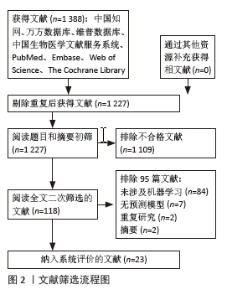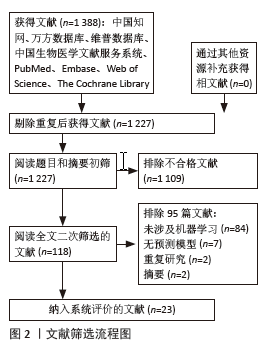Chinese Journal of Tissue Engineering Research ›› 2026, Vol. 30 ›› Issue (3): 740-748.doi: 10.12307/2026.875
Previous Articles Next Articles
A systematic review of application value of machine learning to prognostic prediction models for patients with lumbar disc herniation
Wang Zhipeng1, Zhang Xiaogang1, Zhang Hongwei1, Zhao Xiyun1, Li Yuanzhen1, Guo Chenglong1, Qin Daping1, 2, Ren Zhen3
- 1Department of Orthopedics, Affiliated Hospital of Gansu University of Chinese Medicine, Lanzhou 730020, Gansu Province, China; 2College of Clinical Traditional Chinese Medicine, 3College of Medical Information Engineering, Gansu University of Chinese Medicine, Lanzhou 730020, Gansu Province, China
-
Received:2024-12-04Accepted:2025-02-12Online:2026-01-28Published:2025-07-07 -
Contact:Li Yuanzhen, MS, Associate chief physician, Department of Orthopedics, Affiliated Hospital of Gansu University of Chinese Medicine, Lanzhou 730020, Gansu Province, China -
About author:Wang Zhipeng, MD, Attending physician, Department of Orthopedics, Affiliated Hospital of Gansu University of Chinese Medicine, Lanzhou 730020, Gansu Province, China -
Supported by:Zhang Xiaogang National Famous and Veteran TCM Experts Inheritance Studio Construction Project, TCM Teaching Letter [2022] No. 75 (to GCL); Natural Science Foundation of Gansu Province, No. 24JRRA1037 (to WZP); Gansu Province Young Talents Individual Program, No. 2025QNGR72 (to WZP); Lanzhou Talent Innovation and Entrepreneurship Project, No. 2022-3-25 (to LYZ); Lanzhou Youth Science and Technology Program, No. 2023-2-47 (to WZP)
CLC Number:
Cite this article
Wang Zhipeng, Zhang Xiaogang, Zhang Hongwei, Zhao Xiyun, Li Yuanzhen, Guo Chenglong, Qin Daping, Ren Zhen. A systematic review of application value of machine learning to prognostic prediction models for patients with lumbar disc herniation[J]. Chinese Journal of Tissue Engineering Research, 2026, 30(3): 740-748.
share this article
Add to citation manager EndNote|Reference Manager|ProCite|BibTeX|RefWorks
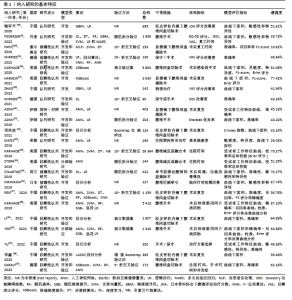
2.2 纳入研究的基本特征和偏倚风险评价结果 纳入研究的基本特征见表1。在23项纳入研究中,有15项是开发及验证研究,其中2项研究是在前期研究开发的模型基础上进行了外部验证;另有8项仅为开发研究。17项研究开发了手术治疗腰椎间盘突出症术后临床疗效的预测模型。1项研究开发及验证了腰椎牵引治疗腰椎间盘突出症后的临床疗效预后模型。在5项研究中,不清楚模型开发的具体治疗措施是手术还是保守治疗。所有研究中的预测因素均大于5项。建模算法方面: PEDERSEN等[4]的研究采用7种机器学习算法进行建模,REN等[27]的研究运用6种机器学习算法进行建模,其余研究机器学习算法均在1-5项。机器学习算法包括梯度提升机、极端梯度提升机、回归算法(逻辑回归、LASSO回归、多元自适应回归、弹性网络回归)、深度学习、决策树、随机森林、支持向量机、K-近邻、朴素贝叶斯及人工神经网络。"
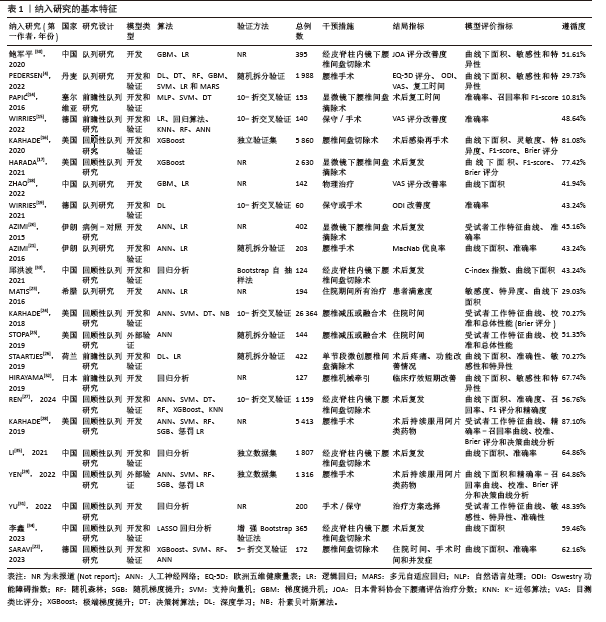
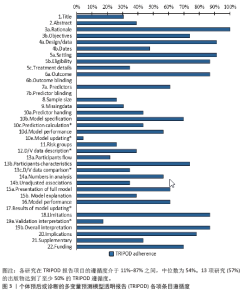
2.3 模型的预测性能 研究主要使用曲线下面积、准确度、敏感度及特异性指标评估模型性能。20个模型报道了模型的曲线下面积,范围为0.561-0.999,其中KARHADE等[16]基于XGBoost算法构建的模型预测性能最好(曲线下面积=0.999)。3个模型报道了模型的准确率,范围为82.07%-89.65%,其中WIRRIES等[19]的研究仅报道了模型的准确度。 2.4 TRIPOD遵循度 遵循度方面,有7个TRIPOD项目达到了至少80%的遵循度(理论背景、研究设计/数据来源、研究设定的关键信息、研究对象的纳入标准、结局指标、局限性讨论和整体解释),而有8个TRIPOD子项目的遵循度低于30%。图3总结了每个项目的报告遵循度。总体而言,各研究在TRIPOD报告项目的遵循度介于11%-87%之间,中位数为54%。13项研究(57%)的出版物达到了至少50%的TRIPOD遵循度。 2.4.1 标题和摘要(项目1和2)以及背景和目的(项目3) 有5项研究完全遵循了标题和摘要的要求。对于纳入研究,预测模型研究类型的描述报告较差,但标题中的目标人群和待预测结果报告大多数研究都是明确的,摘要中的研究机构设置和预测因子报告较少。所有研究对于背景信息进行了良好的报告。但有6项研究对于研究目的未进行说明。 2.4.2 方法(项目4-12) 所有纳入研究在研究设计和结果的定义方面较为全面。研究设置和数据来源在21项研究中报告,关键研究日期在11研究中报告,研究对象的纳入标准在20项研究中报告。8项研究详细描述了治疗措施的细节,20项研究对于结局指标进行了描述,14项研究报告了所有预测因子的定义,样本大小合理性说明在6项研究中报告,7项研究说明如何处理缺失数据的方法。模型性能的评价指标(校准和区分度)在13项研究中报告,有10项研究对模型构建过程进行了详细描述。13项研究报告了内部验证的方法,有6项研究评估了风险群体。未见研究报道结果和预测因子的盲法,未见研究报道模型更新。关于训练集和验证集之间的差异,如数据来源、参与者的资格标准和预测因子的测量,有9项研究进行报告。 2.4.3 结果(项目13-17) 只有1项研究完全遵循模型预测性能的建议;5项研究中描述了参与者和事件的数量;17项研究报告了参与者的特征;有8项研究呈现了完整的模型;6项研究报告了参与者的流动和未经调整的关联;8项研究对训练集和验证集的样本特征进行了对比;有9项研究解释了如何使用模型。 2.4.4 讨论(项目18-20)和其他信息(项目21,22) 20项研究报告了模型的局限性,20项研究报告了结果的整体解释;18项研究报告了模型的潜在临床应用和未来研究的影响;4项开发与验证的研究比较了验证性能与在开发数据中的性能;10项研究提到了附加资源的可用性;16项研究报告了资金信息。"
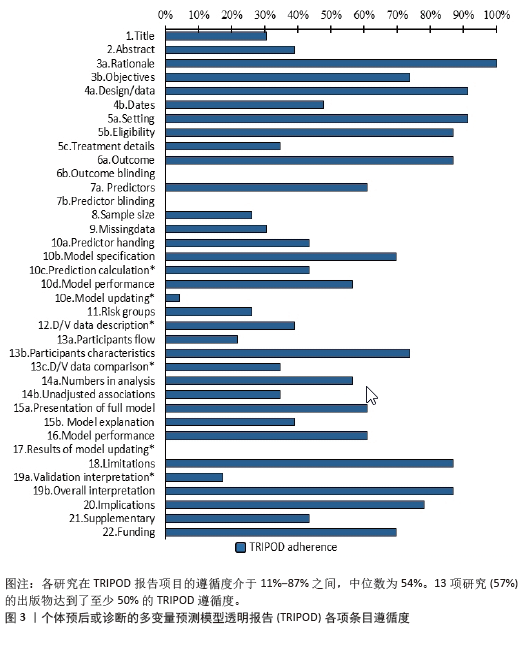
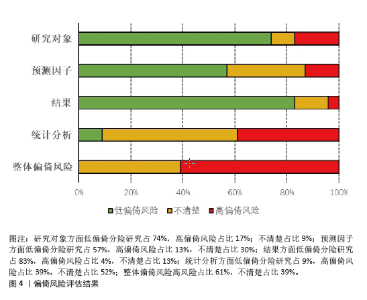
2.5 偏倚风险评估 根据PROBAST评估工具的全部研究整体偏倚风险评估如图4所示。对于所有纳入的23项研究,其中61%具有高整体偏倚风险,39%具有不明确的整体偏倚风险。 领域1:研究对象的偏倚风险判断中,有17项研究被判定为低偏倚风险,2项研究因未提供有关研究对象的纳入和排除信息而被判定为不明确的偏倚风险,剩余4项被判定为高偏倚风险。 领域2:预测因子的偏倚风险判断中,有13项研究的偏倚风险低;7项研究的偏倚风险不明确,主要原因是没有提供关于预测因子评估是否对结果数据进行了遮盖,并且这些回顾性研究中没有报告预测因子的信息。有3项研究在评估预测因子时使用了结果信息,判定为高偏倚风险。 领域3:结果的偏倚风险判断中,19项研究评定为低偏倚风险;1项研究因结果的定义不是标准的且未预先设定,评定为高偏倚风险;3项研究未报告结果确定时是否不清楚预测因子的信息,评定为不明确的偏倚风险。 领域4:统计分析的偏倚风险判断中,有12项研究的偏倚风险不明确,因为很少提供有关处理连续预测因子和分类预测因子组的方法细节、处理缺失数据、模型过度拟合和模型性能的具体要求。有9项研究因有效样本大小较小(定义为每个预测因子事件少于10次)、根据单变量分析选择预测因子和缺乏校准评估而被判定为高偏倚风险。"
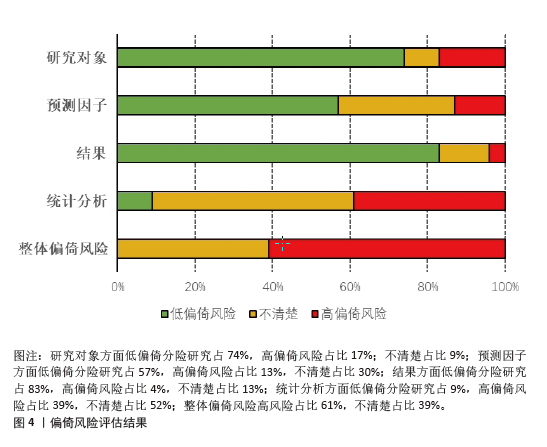
| [1] AMIN RM, ANDRADE NS, NEUMAN BJ. Lumbar Disc Herniation. Curr Rev Musculoskelet Med. 2017;10(4):507-516. [2] DEYO RA, MIRZA SK. CLINICAL PRACTICE. Herniated Lumbar Intervertebral Disk. N Engl J Med. 2016;374(18):1763-1772. [3] 王秀艳, 于希军. 中西医治疗腰椎间盘突出症研究进展[J].现代中西医结合杂志,2019, 28(10):1132-1136. [4] PEDERSEN CF, ANDERSEN MØ, CARREON LY, et al. Applied Machine Learning for Spine Surgeons: Predicting Outcome for Patients Undergoing Treatment for Lumbar Disc Herniation Using PRO Data. Global Spine J. 2022;12(5): 866-876. [5] YOO BR, SON S, LEE SG, et al. Factors Predicting the Clinical Outcome After Trans-sacral Epiduroscopic Laser Decompression for Lumbar Disc Herniation. Neurospine. 2021;18(2):336-343. [6] BI Q, GOODMAN KE, KAMINSKY J, et al. What is machine learning? A primer for the epidemiologist. Am J Epidemiol. 2019;188: 2222-2239. [7] OBERMEYER Z, EMANUEL EJ. Predicting the future - big data, machine learning, and clinical medicine. N Engl J Med. 2016; 375:1216-1219. [8] MOONS KG, DE GROOT JA, BOUWMEESTER W, et al. Critical appraisal and data extraction for systematic reviews of prediction modelling studies: the CHARMS checklist. PLoS Med. 2014;11: e1001744. [9] MOONS KG, ALTMAN DG, REITSMA JB, et al. Transparent reporting of a multivariable prediction model for individual prognosis or diagnosis (TRIPOD): explanation and elaboration. Ann Intern Med. 2015;162: W1-W73. [10] COLLINS GS, REITSMA JB, ALTMAN DG, et al. Transparent reporting of a multivariable prediction model for individual prognosis or diagnosis (TRIPOD): the TRIPOD statement. Eur Urol. 2015;67:1142-1151. [11] MOONS KGM, WOLFF RF, RILEY RD, et al. PROBAST: a tool to assess risk of bias and applicability of prediction model studies: explanation and elaboration. Ann Intern Med. 2019;170:W1-W33. [12] WOLFF RF, MOONS KGM, RILEY RD, et al. PROBAST: A tool to assess the risk of bias and applicability of prediction model studies. Ann Intern Med. 2019;170(1): 51-58. [13] 曹煜隆, 单娇, 龚志忠, 等.个体预后与诊断预测模型研究报告规范:TRIPOD声明解读[J]. 中国循证医学杂志, 2020,20(4):492-496. [14] PAPIĆ M, BRDAR S, PAPIĆ V, et al. Return to Work After Lumbar Microdiscectomy - Personalizing Approach Through Predictive Modeling. Stud Health Technol Inform. 2016;224:181-183. [15] WIRRIES A, GEIGER F, HAMMAD A, et al. AI Prediction of Neuropathic Pain after Lumbar Disc Herniation-Machine Learning Reveals Influencing Factors. Biomedicines. 2022;10(6): 1319. [16] KARHADE AV, BONGERS MER, GROOT OQ, et al. Can natural language processing provide accurate, automated reporting of wound infection requiring reoperation after lumbar discectomy? Spine J. 2020;20(10): 1602-1609. [17] HARADA GK, SIYAJI ZK, MALLOW GM, et al. Artificial intelligence predicts disk re-herniation following lumbar microdiscectomy: development of the “RAD” risk profile. Eur Spine J. 2021;30(8): 2167-2175. [18] ZHAO P, XUE J, XU X, et al. Logistic Model and Gradient Boosting Machine Model for Physical Therapy of Lumbar Disc Herniation. Comput Math Methods Med. 2022;2022:4799248. [19] WIRRIES A, GEIGER F, HAMMAD A, et al. Artificial intelligence facilitates decision-making in the treatment of lumbar disc herniations. Eur Spine J. 2021;30(8): 2176-2184. [20] AZIMI P, MOHAMMADI HR, BENZEL EC, et al. Use of artificial neural networks to predict recurrent lumbar disk herniation. J Spinal Disord Tech. 2015;28(3):E161-E165. [21] AZIMI P, BENZEL EC, SHAHZADI S, et al. The prediction of successful surgery outcome in lumbar disc herniation based on artificial neural networks. J Neurosurg Sci. 2016;60(2): 173-177. [22] SARAVI B, ZINK A, ÜLKÜMEN S, et al. Clinical and radiomics feature-based outcome analysis in lumbar disc herniation surgery. BMC Musculoskelet Disord. 2023;24(1): 791. [23] MATIS GK, CHRYSOU OI, SILVA D, et al. Prediction of Lumbar Disc Herniation Patients’ Satisfaction with the Aid of an Artificial Neural Network. Turk Neurosurg. 2016;26(2):253-259. [24] KARHADE AV, OGINK P, THIO Q, et al. Development of machine learning algorithms for prediction of discharge disposition after elective inpatient surgery for lumbar degenerative disc disorders. Neurosurg Focus. 2018;45(5):E6. [25] STOPA BM, ROBERTSON FC, KARHADE AV, et al. Predicting nonroutine discharge after elective spine surgery: external validation of machine learning algorithms. J Neurosurg Spine. 2019;26:1-6. [26] STAARTJES VE, DE WISPELAERE MP, VANDERTOP WP, et al. Deep learning-based preoperative predictive analytics for patient-reported outcomes following lumbar discectomy: feasibility of center-specific modeling. Spine J. 2019;19(5):853-861. [27] REN G, LIU L, ZHANG P, et al. Machine Learning Predicts Recurrent Lumbar Disc Herniation Following Percutaneous Endoscopic Lumbar Discectomy. Global Spine J. 2024;14(1):146-152. [28] KARHADE AV, OGINK PT, THIO QCBS, et al. Development of machine learning algorithms for prediction of prolonged opioid prescription after surgery for lumbar disc herniation. Spine J. 2019;19(11):1764-1771. [29] YEN HK, OGINK PT, HUANG CC, et al. A machine learning algorithm for predicting prolonged postoperative opioid prescription after lumbar disc herniation surgery. An external validation study using 1,316 patients from a Taiwanese cohort. Spine J. 2022; 22(7):1119-1130. [30] 鲍军平, 刘磊, 时睿, 等. 梯度提升机模型对腰椎间盘突出症经皮内镜切除术近期疗效的预测作用[J]. 中华骨科杂志, 2020,40(19): 1327-1336. [31] YU G, YANG W, ZHANG J, et al. Application of a nomogram to radiomics labels in the treatment prediction scheme for lumbar disc herniation. BMC Med Imaging. 2022; 22(1):51. [32] HIRAYAMA K, TSUSHIMA E, ARIHARA H, et al. Developing a clinical prediction rule to identify patients with lumbar disc herniation who demonstrate short-term improvement with mechanical lumbar traction. Phys Ther Res. 2019;22(1): 9-16. [33] 邱洪波, 唐乐, 何甜, 等. 椎间孔镜治疗腰椎间盘突出症患者术后复发的个体化预警模型的建立[J].西安交通大学学报(医学版),2021,42(6): 817-822. [34] 李鑫, 罗鸣然, 李根, 等. 建立与验证经皮内窥镜腰椎间盘切除后复发风险的预测模型[J].中国组织工程研究,2023, 27(13):2087-2092. [35] LI Y, WANG B, LI H, et al. Adjuvant surgical decision-making system for lumbar intervertebral disc herniation after percutaneous endoscopic lumber discectomy: a retrospective nonlinear multiple logistic regression prediction model based on a large sample. Spine J. 2021;21(12):2035-2048. [36] 陈香萍, 张奕, 庄一渝, 等. PROBAST:诊断或预后多因素预测模型研究偏倚风险的评估工具[J].中国循证医学杂志, 2020,20(6): 737-744. [37] ANDAUR NAVARRO CL, DAMEN JAA, TAKADA T, et al. Risk of bias in studies on prediction models developed using supervised machine learning techniques: systematic review. BMJ. 2021;375:n2281. [38] HALLER MC, ASCHAUER C, WALLISCH C, et al. Prediction models for living organ transplantation are poorly developed, reported, and validated: a systematic review. J Clin Epidemiol. 2022;145: 126-135. [39] MULDER FI, CANDELORO M, KAMPHUISEN PW, et al. The Khorana score for prediction of venous thromboembolism in cancer patients: a systematic review and meta-analysis. Haematologica. 2019; 104(6):1277-1287. [40] COLLINS GS, OGUNDIMU EO, ALTMAN DG. Sample size considerations for the external validation of a multivariable prognostic model: a resampling study. Stat Med. 2016; 35(2):214-226. [41] ZHOU ZR, WANG WW, LI Y, et al. In-depth mining of clinical data: the construction of clinical prediction model with R. Ann Transl Med. 2019;7(23):796. [42] STEKHOVEN DJ, BÜHLMANN P. MissForest--non-parametric missing value imputation for mixed-type data. Bioinformatics. 2012; 28(1):112-118. [43] HARIBHAKTI N, AGARWAL P, VIDA J, et al. A simple scoring tool to predict medical intensive care unit readmissions based on both patient and process factors. J Gen Intern Med. 2021; 36(4):901-907. [44] STEYERBERG EW, HARRELL FE. Prediction models need appropriate internal, internal-external, and external validation. J Clin Epidemiol. 2016;69:245-247. [45] MOONS KG, KENGNE AP, WOODWARD M, et al. Risk prediction models: I. Development, internal validation, and assessing the incremental value of a new (bio)marker. Heart. 2012;98(9):683-690. [46] COLLINS GS, MOONS KGM. Reporting of artificial intelligence prediction models. Lancet. 2019;393:1577-1579. [47] COLLINS GS, DHIMAN P, ANDAUR NAVARRO CL, et al. Protocol for development of a reporting guideline (TRIPOD-AI) and risk of bias tool (PROBAST-AI) for diagnostic and prognostic prediction model studies based on artificial intelligence. BMJ Open. 2021;11:e048008. |
| [1] | Zhang Qian, Huang Dongfeng. Weighted gene co-expression network analysis combined with machine learning to screen and validate biomarkers for osteoarthritis [J]. Chinese Journal of Tissue Engineering Research, 2026, 30(5): 1096-1105. |
| [2] | Gu Fucheng, Yang Meixin, Wu Weixin, Cai Weijun, Qin Yangyi, Sun Mingyi, Sun Jian, Geng Qiudong, Li Nan. Effects of Guilu Erxian Glue on gut microbiota in rats with knee osteoarthritis: machine learning and 16S rDNA analysis [J]. Chinese Journal of Tissue Engineering Research, 2026, 30(4): 1058-1072. |
| [3] | Liao Long, Zhao Zepeng, Li Zongyuan, Yu Qinglong, Zhang Tao, Tang Jinyuan, Ye Nan, Xu Han, Shi Bo. Establishment and validation of a model for femoral head necrosis after internal fixation of femoral neck fracture using logistic regression and SHAP analysis [J]. Chinese Journal of Tissue Engineering Research, 2026, 30(3): 626-633. |
| [4] | Guan Yujie, Zhao Bin. Application and prospect of artificial intelligence in screening and diagnosis of scoliosis [J]. Chinese Journal of Tissue Engineering Research, 2026, 30(3): 721-730. |
| [5] | Yu Weijie, Cao Dongdong, Guo Tianci, Niu Puyu, Yang Jialin, Wang Simin, Liu Aifeng. Risk prediction models of recurrence after percutaneous endoscopic lumbar discectomy: a systematic review and meta-analysis [J]. Chinese Journal of Tissue Engineering Research, 2026, 30(3): 749-759. |
| [6] | Zhao Feifan, Cao Yujing. An artificial neural network model of ankylosing spondylitis and psoriasis shared genes and machine learning-based mining and validation [J]. Chinese Journal of Tissue Engineering Research, 2026, 30(3): 770-784. |
| [7] | Li Jiagen, Chen Yueping, Huang Keqi, Chen Shangtong, Huang Chuanhong. The construction and validation of a prediction model based on multiple machine learning algorithms and the immunomodulatory analysis of rheumatoid arthritis from the perspective of mitophagy [J]. Chinese Journal of Tissue Engineering Research, 2025, 29(在线): 1-15. |
| [8] | Zhang Chunlin, Hou Zhaohua, Yan Xu, Jiang Yan, Fu Su, Ning Yongming, Li Dongzhe, Dong Chao, Liu Xiaokang, Wang Yongkui, Cao Zhengming, Yang Tengyue. Decompression mechanism of symmetrically adduction of lumbar decompression induced resorption of herniated nucleus pulpous [J]. Chinese Journal of Tissue Engineering Research, 2025, 29(9): 1810-1819. |
| [9] | Lu Qi, Sun Maji, Wang Xuezhi, Song Ting, Ma Yiming, Yuan Feng, Chen Hongliang. Two visual arthroplasty techniques for L5-S1 disc herniation: a half-year follow-up evaluation of clinical outcomes [J]. Chinese Journal of Tissue Engineering Research, 2025, 29(9): 1841-1847. |
| [10] | Feng Zhimeng, Sun Ning, Sun Zhaozhong, Li Yuefei, Liu Changzhen, Li Sa. Three-dimensional image reconstruction can safely assist one-hole split endoscope in treatment of #br# L5/S1 far lateral lumbar disc herniation [J]. Chinese Journal of Tissue Engineering Research, 2025, 29(9): 1876-1882. |
| [11] | Wang Mi, Ma Shujie, Liu Yang, Qi Rui. Identification and validation of characterized gene NFE2L2 for ferroptosis in ischemic stroke [J]. Chinese Journal of Tissue Engineering Research, 2025, 29(7): 1466-1474. |
| [12] | Zhi Fang, Zhu Manhua, Xiong Wei, Lin Xingzhen. Analgesic effect of acupuncture in a rat model of lumbar disc herniation [J]. Chinese Journal of Tissue Engineering Research, 2025, 29(5): 936-941. |
| [13] | Liu Yani, Yang Jinghuan, Lu Huihui, Yi Yufang, Li Zhixiang, Ou Yangfu, Wu Jingli, Wei Bing . Screening of biomarkers for fibromyalgia syndrome and analysis of immune infiltration [J]. Chinese Journal of Tissue Engineering Research, 2025, 29(5): 1091-1100. |
| [14] | Yang Bin, Tao Guangyi, Yang Shun, Xu Junjie, Huang Junqing . Visualization analysis of research hotspots of artificial intelligence in field of spinal cord nerve injury and repair [J]. Chinese Journal of Tissue Engineering Research, 2025, 29(4): 761-770. |
| [15] | Yang Dingyan, Yu Zhenqiu, Yang Zhongyu. Machine learning-based analysis of neutrophil-associated potential biomarkers for acute myocardial infarction [J]. Chinese Journal of Tissue Engineering Research, 2025, 29(36): 7909-7920. |
| Viewed | ||||||
|
Full text |
|
|||||
|
Abstract |
|
|||||
